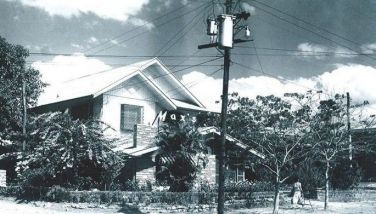A SEA Games first
August 22, 2005 | 12:00am
The final bell has long rung. The winner’s hand has been raised, the national anthem played. The fighters, with flecks of blood mixing with the salty sweat on their jerseys, head to their corners, breathe heavily, unstrap their headgear.
And flip their hair.
Women’s boxing makes its debut in the Philippine Southeast Asian Games, and this is so far removed from the original laws of the Olympics, when women weren’t even allowed to participate in running events, let alone try to slug it out with each other.
The sport picked up steam only in the last seven years or so, when mainstream boxing gyms like Elorde Sports Center in Parañaque started offering it to the distaff side, and a few brave souls tried it. Then, Muhammad Ali’s daughter, Laila, turned professional, and had a highly-publicized slugfest with a Joe Frazier progeny, sort of reliving the three heavyweight title fights their fathers fought a generation before. Then, Clint Eastwood’s drama "Million Dollar Baby" with the sensational Hilary Swank became both a mass and critics’ favorite at the Oscars. Add to this the brisk sales of hybrid taebo tapes and similar contact sport videos for women, and the sport has picked up quite a bit of momentum.
"There are really 13 weight divisions in women’s boxing," explains national women’s assistant coach and 1992 Barcelona Olympics bronze medalist Roel Velasco in the vernacular. "But for the SEA Games, there will only be five."
Surprisingly, our national women’s team has accorded itself very well in international competition of late. Two weeks ago, the Philippine women’s team picked up a gold and two silvers in the Asian championships held in China.
There are some minor differences in women’s boxing, though. There are only three two-minute rounds in a women’s bout, with one-minute rest periods in between. So it is much more challenging to make an impression on the judges.
"Three of the five judges still need to press their controls on the computer at the same time to acknowledge the point," explains Velasco, whose younger brother Onyok claimed a silver medal in the controversial gold medal match against Bulgarian Daniel Petrov Bojilov at the 1996 Atlanta Games. "If only two of them press the button, then you don’t get the point. It’s still the same problem."
The same rules still apply in other respects. You must make contact with only the white part of the glove, you can only hit the opponent in the head and torso, not the back of the head of back. You still get three warnings before a point is deducted, and low blows are definitely still a no-no.
"If the referee sees a fighter is hurt, he can step in and give a standing eight count," Velasco elaborates. "But if the fighter recovers, then the fight continues, so women’s amateur boxing is very safe."
The rigors of training are still the same, in every respect. Our women’s boxing team starts their roadwork at 5:30 to 7:30 every morning at the Rizal Memorial sports complex. Then they come back to spar, shadow box and work the speed bag and heavy bag at 1 p.m. This goes on six days a week, with no time to really give in to regular female discomforts like menstrual cramps. And some of them are students with full loads, as well. Nevertheless, our female pugilists are determined not to let their countrymen down.
"We will really work hard, because this is for the country," Velasco concludes. "The training has been very effective, and we just took a break after China. But now, we’re gradually building up for the SEA Games."
Although our women’s boxers will definitely be overshadowed by their traditional male counterparts, every gold medal will count, as the country tries to match its outstanding 91-gold total the last time the games were held here. It’s definitely a long shot, but what else are our athletes going to do except try their mightiest?
And that includes our women warriors of the squared circle, too. How many first chances do you get?
Catch Jayjay Helterbrand, Anthony Washington, and the Gillette Metro Basketball League on The Basketball Show tonight at 8:30 p.m. over IBC-13.
And flip their hair.
Women’s boxing makes its debut in the Philippine Southeast Asian Games, and this is so far removed from the original laws of the Olympics, when women weren’t even allowed to participate in running events, let alone try to slug it out with each other.
The sport picked up steam only in the last seven years or so, when mainstream boxing gyms like Elorde Sports Center in Parañaque started offering it to the distaff side, and a few brave souls tried it. Then, Muhammad Ali’s daughter, Laila, turned professional, and had a highly-publicized slugfest with a Joe Frazier progeny, sort of reliving the three heavyweight title fights their fathers fought a generation before. Then, Clint Eastwood’s drama "Million Dollar Baby" with the sensational Hilary Swank became both a mass and critics’ favorite at the Oscars. Add to this the brisk sales of hybrid taebo tapes and similar contact sport videos for women, and the sport has picked up quite a bit of momentum.
"There are really 13 weight divisions in women’s boxing," explains national women’s assistant coach and 1992 Barcelona Olympics bronze medalist Roel Velasco in the vernacular. "But for the SEA Games, there will only be five."
Surprisingly, our national women’s team has accorded itself very well in international competition of late. Two weeks ago, the Philippine women’s team picked up a gold and two silvers in the Asian championships held in China.
There are some minor differences in women’s boxing, though. There are only three two-minute rounds in a women’s bout, with one-minute rest periods in between. So it is much more challenging to make an impression on the judges.
"Three of the five judges still need to press their controls on the computer at the same time to acknowledge the point," explains Velasco, whose younger brother Onyok claimed a silver medal in the controversial gold medal match against Bulgarian Daniel Petrov Bojilov at the 1996 Atlanta Games. "If only two of them press the button, then you don’t get the point. It’s still the same problem."
The same rules still apply in other respects. You must make contact with only the white part of the glove, you can only hit the opponent in the head and torso, not the back of the head of back. You still get three warnings before a point is deducted, and low blows are definitely still a no-no.
"If the referee sees a fighter is hurt, he can step in and give a standing eight count," Velasco elaborates. "But if the fighter recovers, then the fight continues, so women’s amateur boxing is very safe."
The rigors of training are still the same, in every respect. Our women’s boxing team starts their roadwork at 5:30 to 7:30 every morning at the Rizal Memorial sports complex. Then they come back to spar, shadow box and work the speed bag and heavy bag at 1 p.m. This goes on six days a week, with no time to really give in to regular female discomforts like menstrual cramps. And some of them are students with full loads, as well. Nevertheless, our female pugilists are determined not to let their countrymen down.
"We will really work hard, because this is for the country," Velasco concludes. "The training has been very effective, and we just took a break after China. But now, we’re gradually building up for the SEA Games."
Although our women’s boxers will definitely be overshadowed by their traditional male counterparts, every gold medal will count, as the country tries to match its outstanding 91-gold total the last time the games were held here. It’s definitely a long shot, but what else are our athletes going to do except try their mightiest?
And that includes our women warriors of the squared circle, too. How many first chances do you get?
BrandSpace Articles
<
>
- Latest
- Trending
Trending
Latest
Trending
Latest
Recommended


























